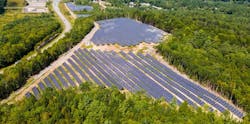Syncarpha Capital gets nod to operate first Community Solar in Maine
Community solar developer Syncarpha Capital has obtained regulatory permission to operate its first project in Maine that will power more than 1,000 households connected to the Central Maine Power grid.
Located in Maine's capital city, Augusta, the solar farm is built on a land owned by Syncarpha's partner, Acadia Energy, and features a ground-mounted photovoltaic system with a capacity to generate 6.5 MW of electricity.
“It is always a great feeling for us to see residents and the environment benefit from the transformation of unused space,” Michael Atkinson, Director of Development at Syncarpha Capital said. “We are fortunate to have partnered with Acadia Energy and are happy to be a part of helping Maine reach its clean energy goal of being 100% renewable and look forward to seeing more community solar throughout the state.”
Arcadia Energy also has worked with Standard Solar on developing a 7.5-MW solar farm at an industrial park in Fort Fairfield, Maine.
Central Maine Power customers can subscribe to the community solar at no upfront cost, according to the release.
Syncarpha Capital is a New York-based private equity firm focused on utility-scale and distributed solar projects in North America.
About the Author
EnergyTech Staff
Rod Walton is senior editor for EnergyTech.com. He has spent 17 years covering the energy industry as a newspaper and trade journalist.
Walton formerly was energy writer and business editor at the Tulsa World. Later, he spent six years covering the electricity power sector for Pennwell and Clarion Events. He joined Endeavor and EnergyTech in November 2021.
He can be reached at [email protected].
EnergyTech is focused on the mission critical and large-scale energy users and their sustainability and resiliency goals. These include the commercial and industrial sectors, as well as the military, universities, data centers and microgrids.
Many large-scale energy users such as Fortune 500 companies, and mission-critical users such as military bases, universities, healthcare facilities, public safety and data centers, shifting their energy priorities to reach net-zero carbon goals within the coming decades. These include plans for renewable energy power purchase agreements, but also on-site resiliency projects such as microgrids, combined heat and power, rooftop solar, energy storage, digitalization and building efficiency upgrades.
